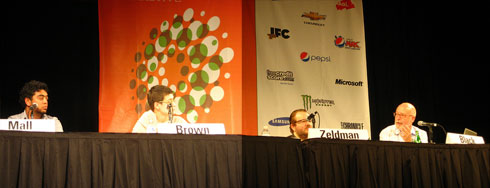
ONE GLORIOUS AFTERNOON in March, 2006, as a friend and I hurried past Austin’s Downtown Hilton Hotel to catch the next session of the SXSW Interactive Festival, a young stranger arrested our progress. With no introduction or preliminaries, he announced that he was available to speak at An Event Apart, a conference for web designers that Eric Meyer and I had launched three months previously. Turning to my companion with my best impression (which is none too good) of Mr Burns of “The Simpsons,” I asked, “Who is this brash young upstart, Smithers?”
The brash young upstart quickly became an essential colleague. In the months and years that followed, Aaron Gustafson created dazzling front- and back-end code for some of my agency’s most demanding clients. Just as importantly, he brilliantly tech-edited the second and third editions of Designing With Web Standards. The job largely consists of alerting Ethan Marcotte and me to the stuff we don’t know about web standards. I’ll let you think about that one. For five years now, Aaron has also been a tough but fair technical editor for A List Apart magazine, where he helps authors succeed while ensuring that they are truly innovative, that their methods are accessible and semantic, and (thanks to his near-encyclopedic knowledge) that they give all prior art its due. Moreover, Aaron has written seminal pieces for the magazine, and, yes, he has lectured at An Event Apart.
Given my experiences with the man and my admiration for his knowledge and abilities, I was thrilled when Aaron told me the premise of this book and began letting me look at chapters. This isn’t just another web design book. It’s an essential and missing piece of the canon. Our industry has long needed a compendium of best practices in adaptive, standards-based design. And with the rise of mobile, the recent significant improvements in desktop and phone browsers, and the new capabilities that come with HTML5, CSS3, and gestural interfaces, it is even more vital that we who make websites have a reliable resource that tells us how to take advantage of these new capabilities while creating content that works in browsers and devices of all sizes and widely differing capabilities. This book is that resource.
The convergence of these new elements and opportunities is encouraging web professionals to finally design for the web as it always should have been done. Adaptive design is the way, and nobody has a wider command than Aaron of the thinking and techniques required to do it well. In these pages you will find all that thinking and those methods. Never again will you lose a day debating how to do great web design (and create great code) that works for everyone. I plan to give this book to all my students, and to everyone I work with. I encourage you to do likewise. And now, enough preliminaries. Dive in, and enjoy!
Adaptive Web Design: Crafting Rich Experiences with Progressive Enhancement
by Aaron Gustafson
Foreword by Jeffrey Zeldman







